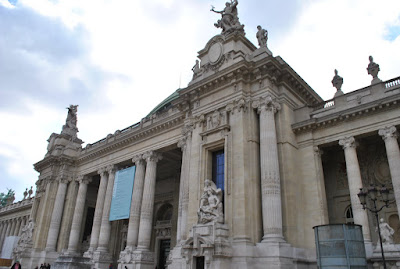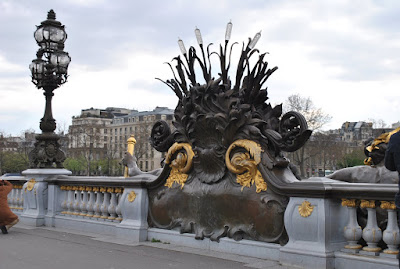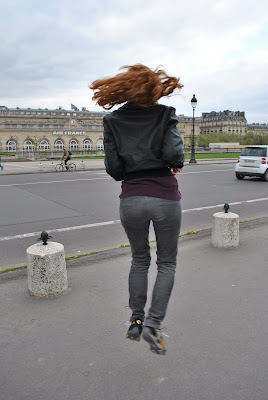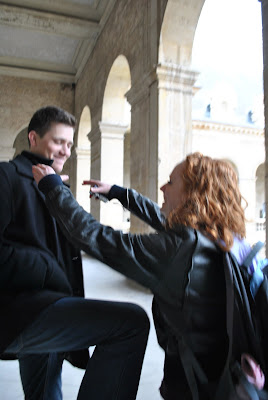Day 80 - Test and Last Walk (#4)
I've been here for eighty days! That is crazy! I come home in 9 days. Wow. I'm sure you all have been counting down the days on your personal calendar. Okay, maybe not. But I hope I've been missed because I've certainly missed everyone back at home!
Anyway, I took my last chapter test today. It went really well! It was short and pretty dang easy. I waited while the others (the 201 students were taking their test) finished up. Then Hanna, Garret, and I went and got some Thai (Je pense...) food. A little too minty, but good. Then we headed to do Walk #4 entitled Of Art, War, and World's Fairs: Les Invalides, Musée Rodin, La Tour Eiffel.
Anyway, I took my last chapter test today. It went really well! It was short and pretty dang easy. I waited while the others (the 201 students were taking their test) finished up. Then Hanna, Garret, and I went and got some Thai (Je pense...) food. A little too minty, but good. Then we headed to do Walk #4 entitled Of Art, War, and World's Fairs: Les Invalides, Musée Rodin, La Tour Eiffel.
 Le Grand Palais. "The two palais were built between 1897 and 1900 for the Exposition Universelle (World's Fair) in 1900 and were designed with both neo-classical elements and elements of the just emerging Art Nouveau style. They house various art exhibits that rotate regularly and have recently featured artists as diverse as Gauguin, Picasso, and Walt Disney (and Turner, who is there right now!). In addition to art exhibits, the Grand Palais has hosted sporting events, primarily equestrian competitions. (Fencing was slated to be held here had Paris won the bid for the 2012 Summer Olympics.)"
Le Grand Palais. "The two palais were built between 1897 and 1900 for the Exposition Universelle (World's Fair) in 1900 and were designed with both neo-classical elements and elements of the just emerging Art Nouveau style. They house various art exhibits that rotate regularly and have recently featured artists as diverse as Gauguin, Picasso, and Walt Disney (and Turner, who is there right now!). In addition to art exhibits, the Grand Palais has hosted sporting events, primarily equestrian competitions. (Fencing was slated to be held here had Paris won the bid for the 2012 Summer Olympics.)"
 "This avenue [Winston Churchill] connects the Elysée Palace (where the French President lives) with the Invalides in front of you. It forms a symbolic connection between the French Republic and the French Revolution (Napoleon, symbol of the revolution, is buried beneath the large golden dome beneath the large golden dome just across the river)."
"This avenue [Winston Churchill] connects the Elysée Palace (where the French President lives) with the Invalides in front of you. It forms a symbolic connection between the French Republic and the French Revolution (Napoleon, symbol of the revolution, is buried beneath the large golden dome beneath the large golden dome just across the river)."





 "The bridge you are standing on, named after Russian Czar Alexandre III, was built at the same time as the Grand and Petit Palais and symbolizes the friendship between Russia and France. The first stone was place in 1896 by Nicolas II, Alexandre III's successor, but in the beginning people called it the 'Exposition' Bridge since it opened for the 1900 Exposition Universelle. Notice the bridge is made of a single arch that spans the entire river (a big deal when it was built). The gilded sculptures represent Pegasus held by la Renommée (fame)."
"The bridge you are standing on, named after Russian Czar Alexandre III, was built at the same time as the Grand and Petit Palais and symbolizes the friendship between Russia and France. The first stone was place in 1896 by Nicolas II, Alexandre III's successor, but in the beginning people called it the 'Exposition' Bridge since it opened for the 1900 Exposition Universelle. Notice the bridge is made of a single arch that spans the entire river (a big deal when it was built). The gilded sculptures represent Pegasus held by la Renommée (fame)."The Musée Rodin was next on the agenda, but we had all already been there, so here is just some info:
"The Hotel Biron, home of the Rodin Museum, was built in the 1720s and is a good example of the Rococo style. Rodin lived here in the early 20th century, and the chateau and surrounding park became a museum in 1919, two years after Rodin's death."

 "You may have noticed a moat around the grounds (obviously); it was never filled with water, but it did serve (in theory) to protect the stock of arms kept on the premises. Originally, the Invalides was built to accomodate the soldiers injured during the wars waged by Louis XIV. The first veterans moved in during 1674. The classical style church of the Dôme, constructed by Jules Hardouin-Mansart, was inaugurated by Louis XIV in 1706. During the French Revolution, the church of the Dôme was dedicated to Mars, the god of war, and to the virtues of war. In 1840, bowing to political pressure, King Louis-Philippe had the church overhauled and placed Napoleon's remains in it (along with the remains of other important military figures). Today, part of the Hôtel des Invalides has been transformed into Le musée de l'armée and part is still used as a care facility for veterans." Exciting, no? :)
"You may have noticed a moat around the grounds (obviously); it was never filled with water, but it did serve (in theory) to protect the stock of arms kept on the premises. Originally, the Invalides was built to accomodate the soldiers injured during the wars waged by Louis XIV. The first veterans moved in during 1674. The classical style church of the Dôme, constructed by Jules Hardouin-Mansart, was inaugurated by Louis XIV in 1706. During the French Revolution, the church of the Dôme was dedicated to Mars, the god of war, and to the virtues of war. In 1840, bowing to political pressure, King Louis-Philippe had the church overhauled and placed Napoleon's remains in it (along with the remains of other important military figures). Today, part of the Hôtel des Invalides has been transformed into Le musée de l'armée and part is still used as a care facility for veterans." Exciting, no? :)







 Then we went off to Napoleon's tomb. We didn't go into the army museum because we didn't end of having time, but here is a little bit of info that I thought was crazy: "You may be surprised how large [the World War I section] is. This is, in part, because of the huge scar this war left on France. The French won the Battle of Verdun but lost more men in that single battle than America has lost in all its foreign wars combined. During World War I, over four million French were killed or wounded, approximately ELEVEN percent of the entire population." This blows my mind.
Then we went off to Napoleon's tomb. We didn't go into the army museum because we didn't end of having time, but here is a little bit of info that I thought was crazy: "You may be surprised how large [the World War I section] is. This is, in part, because of the huge scar this war left on France. The French won the Battle of Verdun but lost more men in that single battle than America has lost in all its foreign wars combined. During World War I, over four million French were killed or wounded, approximately ELEVEN percent of the entire population." This blows my mind.









 :) The end of the walk was at the Eiffel Tower, but we see it all the time! But here is some info for you, in case you are interested. If not, stop here because this was the end of my day! I just went home, worked on homework, and slept :)
:) The end of the walk was at the Eiffel Tower, but we see it all the time! But here is some info for you, in case you are interested. If not, stop here because this was the end of my day! I just went home, worked on homework, and slept :)"The Champ-de-Mars, so named because of the military exercises conducted here in the past, is now a large park that links the École Militaire with the Eiffel Tower... Since the École Militaire is still used as a school for officers in the French military, you can't go in it, but you may appreciate its classical facade. It was built in the early 1700s, during the reign of Louis XV at the insistence of his mistress, Madame de Pompadour. It was in the cour intérieure (courtyard), just behind the central facade, that Alfred Dreyfus was stripped of his rank in 1895 and where he became a member of the Legion of Honor in 1906 (See Walk 3).
"The Eiffel Tower was built for the Exposition Universelle in 1889 - one hundred years after the revolution - to demonstrate France's engineering prowess. It was the tallest structure in the world and retained that distinction until 1930. Many Parisians originally despised Gustave Eiffel's creation. Author Guy de Maupassant said he liked to go to the restaurant on the Eiffel Tower because it was the only place he could eat without having to look at it. The tower was supposed to be torn down in 1909 but was saved only because it functioned as a brodcast tower. Today, it is the most recognizable building in the world, and the symbol of Paris." Kind of ironic, don't you think?
"Here are some interesting facts about the Eiffel Tower: Sixty tons of paint are required to cover it (on average, it has been painted once every seven years). Over the years, it has been painted red, yellow, and now brown. Different shades of paint are used so that the Tower appears to be a uniform color when looked at against the sky. It weighs over ten thousand tons and contains two and a half million rivets. Names of important scientists and engineers are inscribed on each side of the tower (18 per side, 72 in all). At night, flashing lights illuminate that tower for ten minutes at the top of every hour."










Comments